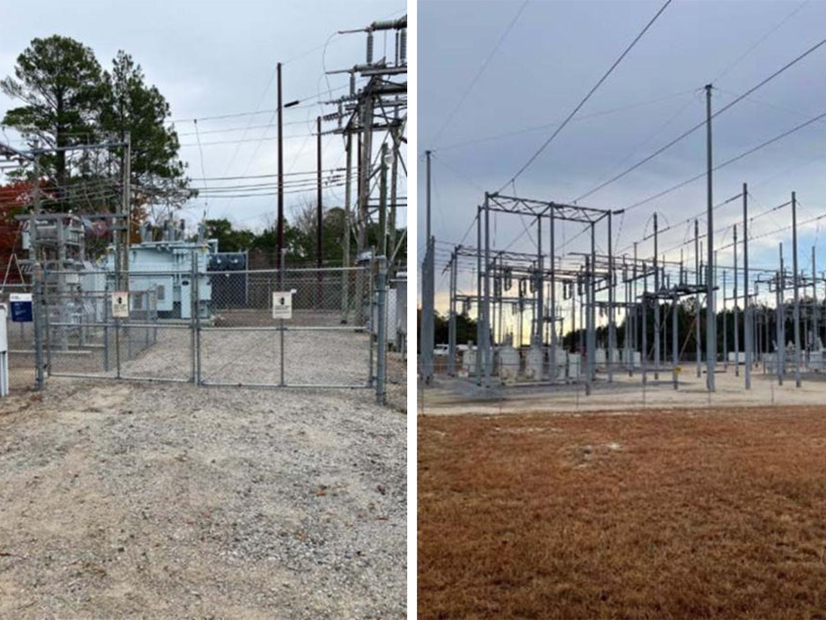
NERC told FERC in a report Friday that it will soon begin a new standards development project to examine changes to reliability standard CIP-014-3 (Physical security) in response to the ongoing threat of physical violence against grid assets.
FERC ordered the report at its December open meeting citing recent physical security incidents, primarily the Dec. 3 gunfire attack on two Duke Energy (NYSE:DUK) substations in North Carolina, which left 45,000 customers without power for as long as four days (RD23-2). (See FERC Orders NERC Review on Physical Security.)
Physical security has remained a pressing concern since then because of subsequent sabotage events in Seattle and Las Vegas, as well as the arrest of a neo-Nazi leader for plotting to attack electric substations in Baltimore. (See Feds Charge Two in Alleged Conspiracy to Attack BGE Grid.) NERC CEO Jim Robb said in a statement that the “heightened physical security threat environment and the high-profile attacks … in the fourth quarter of 2022” made the new report a priority for the ERO Enterprise.
“Our study outlines actions to strengthen the physical security standard and foster robust stakeholder engagement to consider additional risk-based enhancements,” Robb said. “The actions outlined in our report will help further secure critical bulk power system assets and ensure the foundational protections of CIP-014 are keeping pace with a dynamic risk environment.”
Standard Modifications Planned
CIP-014-3 was approved by FERC last year with the purpose of identifying and protecting transmission stations and substations that, if damaged in a physical attack, “could result in instability, uncontrolled separation, or cascading within an interconnection.” It requires transmission owners to perform periodic risk assessments of their transmission facilities and control centers to determine which of them are critical to reliability, evaluate their potential physical security threats and vulnerabilities, and develop a security plan to address those threats.
The commission wanted NERC to assess the effectiveness of CIP-014-3 in light of the North Carolina attacks. FERC ordered the ERO to evaluate the adequacy of the standard’s applicability criteria, the adequacy of the required risk assessment, and whether a minimum level of protection should be required for all substations on the North American grid.
In the report, NERC said that the criteria are still appropriate to “focus limited industry resources” on the most critical grid facilities, and that its evidence suggested that expanding the criteria would not identify any additional critical substations. As a result, the ERO recommended against expanding the criteria.
However, the ERO also acknowledged that “supplemental data” such as “expansion plans, future year realized conditions, impacts of grid transformation, and other similar projections that alter year-to-year … could alter substation configuration” and bring currently unqualified facilities under the jurisdiction of the standard. NERC plans to hold a technical conference with FERC to identify the type of substation configurations to be studied, and to establish data needs for conducting those studies; the conference has not been scheduled.
NERC did find that the standard’s language requiring TOs to study the effect of losing a substation needs “additional clarification as [to] how registered entities must conduct the assessments.” The report said that utilities’ approaches to the studies are inconsistent in both their methods and their frequency. Although this can occur because they lack in-house subject matter experts, the root cause is “a lack of specificity in the requirement language,” NERC said.
The ERO said it will begin a new project to examine the issue and determine how the standard could be modified to provide more clarity. Suggested objectives of the project include clarifying the methods for studying instability, uncontrolled separation, and cascading; clarifying the documentation and usage of criteria to identify instability, uncontrolled separation, or cascading; and clarifying the risk assessment to account for adjacent substations of differing ownership.
Conference to Address Minimum Security Requirements
Finally, in response to FERC’s question about requiring that protection be implemented on all grid facilities, NERC suggested that a “more holistic approach [would] provide greater long-term flexibility and minimize the impacts of physical attacks on [grid] reliability.” The ERO acknowledged that a uniform set of protections might prevent some physical damage but warned that it would not “guarantee the protections will safeguard against more sophisticated or coordinated attacks.”
However, NERC also suggested a second technical conference to evaluate “the appropriate combination of reliability, resiliency and security measures that would be effective in helping to mitigate the impact of physical security attacks.” Topics covered by the conference will include:
- the appropriate approach to identifying the objective of a minimum level of protections, risks to be mitigated and industry resources necessary to meet minimum requirements;
- expanding the use of planning studies to evaluate physical security attacks and develop corrective action plans to deal with inadequate performance;
- enhancing operational planning assessments to include loss of assets from physical attacks; and
- enhancing transmission planning and TO requirements to ensure spare equipment pools are appropriate to respond to security incidents.
NERC will use the technical conference as a basis for determining its future moves, including additional changes to its reliability standards. The conference, like the one dedicated to the applicability criteria, has not been scheduled.



